Geckeler K.E., Nishide H. (Eds.) Advanced Nanomaterials
Подождите немного. Документ загружается.


13.2 Polyolefi n-Based Nanocomposites 415
shown to be adequate in offering a surplus enthalpy for promoting OLS dispersion
into a nonpolar matrix, as did a PO. In fact, the surfactant/silicate interactions
were more favorable compared to those of PO/silicates. Hence, the synthetic
approach was directed towards reducing the enthalpic interactions between the
clay and surfactant by using semi - fl uorinated surfactants [52] as clay modifi ers.
Although, in the case of PP/OLS composites this approach led to a signifi cant
improvement in miscibility, this type of surfactant was seen to be much too expen-
sive for use in the mass production of PO nanocomposites.
A more general approach for improving the compatibility of a PO with OLS was
to introduce into the system a compatibilizer as the coupling agent. In general,
the compatibilizer was a functionalized PO, such as a maleic anhydride ( MAH ) or
maleate ester - grafted PO, an oligomeric - functionalized PO, or an ammonium -
terminated or OH - terminated PO, as well as a suitable block or random copolymer
(Table 13.4 ). These types of polymer or oligomer refl ected some of the theoretical
calculations carried out to probe the interactions between polymers and clay
sheets, and were used substantially to design the ideal compatibilizer [70, 71] . It
became clear that for the simple penetration of polymer chains into the clay gallery,
the compatibilizer should contain a fragment which would be highly attracted by
the clay surface. In addition, it should incorporate a longer fragment that was not
attracted by the sheets, but rather would attempt to gain entropy by pushing the
layers apart. Subsequently, when the layers had separated, the surfaces would be
sterically hindered from coming into close contact. In this way the compatibilizer
could be seen to behave as a steric stabilizer for the PO/OLS colloidal suspension.
Thus, the role of the compatibilizer is not only to favor a layered silicate dispersion
and to enhance the polarity of the polymer matrix, but also to stabilize the fi nal
morphology. The strong interactions between the compatibilizer and clay are not
only fundamental for the dispersion step, but also for maintaining the
morphology.
Initial attempts to improve the interactions between nonpolar PO and layered
silicates were carried out by melt - mixing the polymer and clay with modifi ed oli-
gomers, so as to mediate the polarity [51, 55 – 57, 74] . Usuki et al . [55] were fi rst to
report the preparation of PP/layered silicate nanocomposites using a functional
oligomer (PP – OH) with polar telechelic – OH groups as compatibilizer. In this
approach, PP – OH was intercalated between the layers of an OLS, after which the
PP – OH/OLS was melt - mixed with PP to obtain nanocomposites with an interca-
lated structure. Another typical example to be reported was that of PP/layered sili-
cate nanocomposites; these were prepared by Toyota, using PP oligomers modifi ed
with approximately 10 wt% of MAH groups [51, 56] and clays exchanged with
stearyl ammonium cations. Wide - angle X - ray diffraction ( WAXD ) analyses and
TEM observations established the intercalated structure for all of these nanocom-
posites. Here, the driving force of the intercalation was considered to have origi-
nated from the interaction between the MAH group and the oxygen groups of the
silicate, through the formation of hydrogen bonding (Figure 13.3 ).
In general, the compatibilizer is a polymer in which the functional groups are
distributed randomly along the backbone, or functionalized at the chain end. Both,
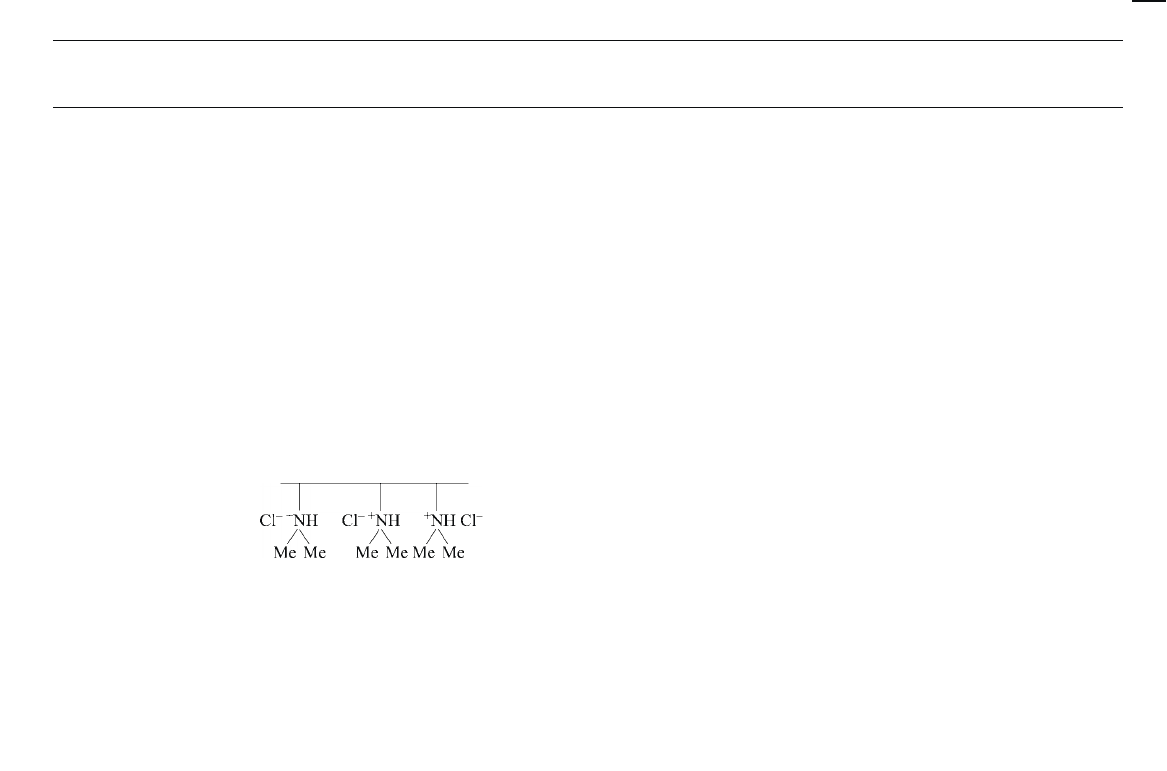
416 13 Nanocomposites Based on Phyllosilicates
Table 13.4 Some examples of compatibilizers for the preparation of PO / OLS nanocomposites.
Types of compatibilizer for
PO/OLS systems
Examples Main characteristics Reference(s)
End - functionalized
oligomers (i.e., OH - ;
MAH - terminated)
OH end - functionalized PP oligomer
M
w
(by GPC) 20 000; OH value 54 mg KOH g
− 1
[52, 56, 58]
MAH end - functionalized PP oligomer M
w
(by GPC) 12 000 – 30 000. Acid value
7 – 52 mg KOH g
− 1
[52, 56, 58]
MAH end - functionalized PE oligomer M
n
5700. Acid value; weight fraction of polar
comonomer 0.01). This PE - g - MA has a low
anhydride content so that, on average, there is
one anhydride moiety per two molecules. It can
be considered as an end - functionalized PE
oligomer.
[64]
End - functionalized
polymers (i.e., NH
3
- , OH - ,
COOH - terminated)
Linear end - functionalized polyethylene with
dimethyl ammonium chloride end groups
Narrow molecular weight distribution [74, 75]
Polyethylene with multiple quaternized amine
groups along the polymer chain
Narrow molecular weight distribution [75]
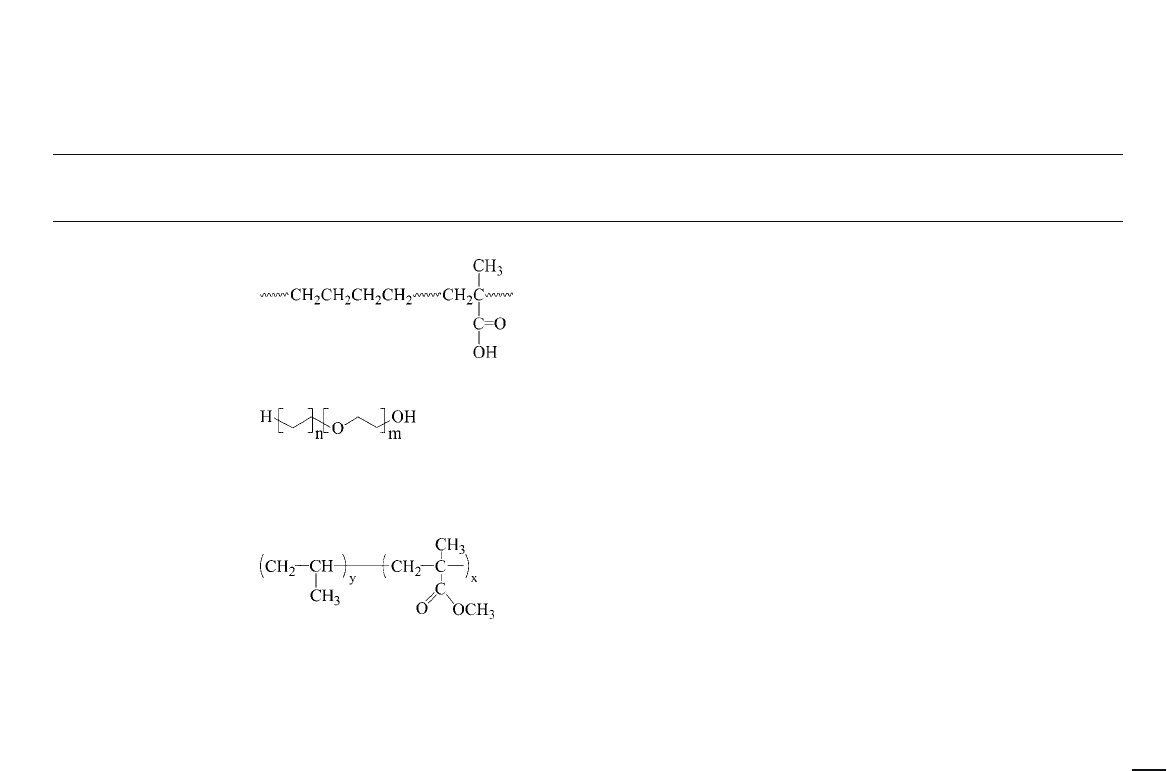
13.2 Polyolefi n-Based Nanocomposites 417
Types of compatibilizer for
PO/OLS systems
Examples Main characteristics Reference(s)
Block copolymers Poly(ethylene - block - methacrylic acid)
Narrow molecular weight distribution [75]
Poly(ethylene - block - ethylene glycol)
Mn (575 mol g
− 1
); 0.20 molar fraction of polar
comonomer; PE - b - PEG is a block - copolymer, the
chains of which contain 33 methylene groups
and 2.6 ethylene oxide units per molecule on
average
[64]
Poly(propylene - block - methyl methacrylate)
M
w
around 200 000; molar fraction of MMA
units 1 or 5
[52]
Styrene - b - ethylene/butylenes - b - styrene block
copolymer
A triblock copolymer based on hydrogenated
polybutadiene (10 wt% ethyl branches,
M
n
= 37 000 g mol
− 1
) central block and
polystyrene (30 wt%, M
n
= 7000 g mol
− 1
)
[76]
Table 13.4 Continued.
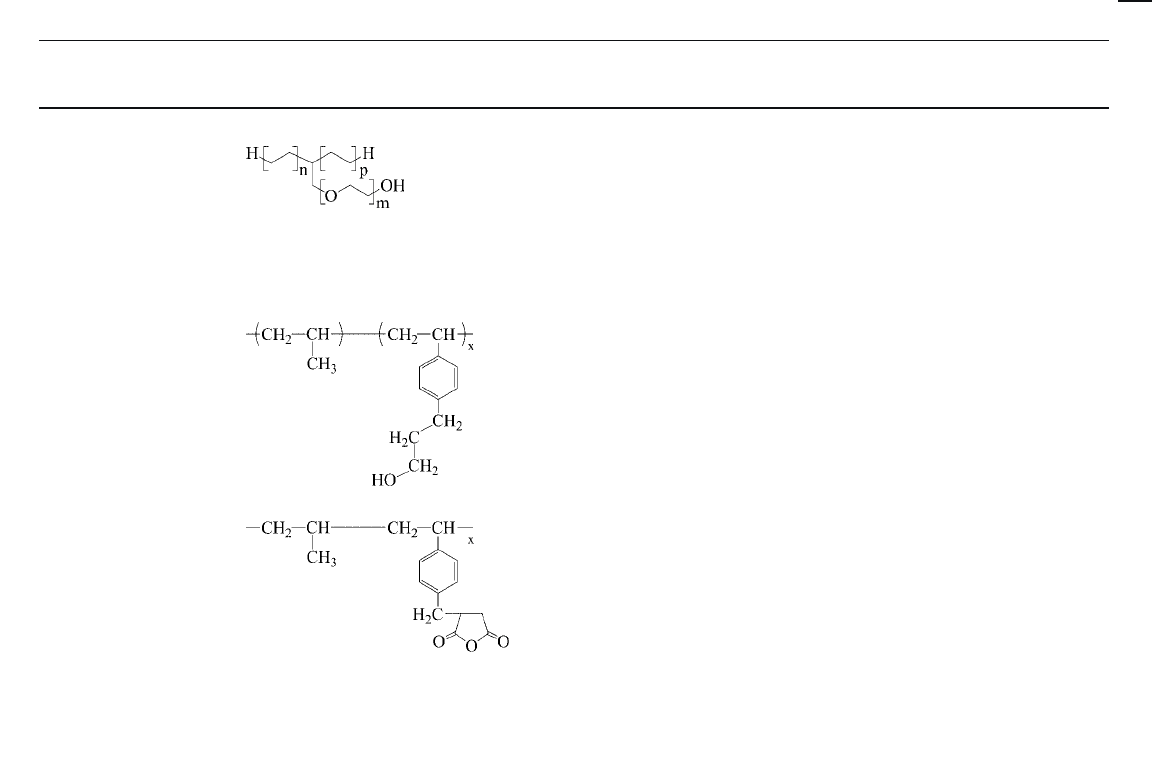
418 13 Nanocomposites Based on Phyllosilicates
Types of compatibilizer for
PO/OLS systems
Examples Main characteristics Reference(s)
Random copolymers Poly(ethylene - co - vinyl alcohol)
0.69 weight fraction of polar comonomer [64, 76]
Poly(ethylene - co - methacrylic acid) M
n
68 000; 0.11 weight fraction of polar
comonomer.
[64]
PP - r - (PP - OH)
x
PP - r - (PP - MA)
x
These copolymers derive from a random
polypropylene copolymer which contains 1
mol% p - methylstyrene comonomer.
Mw around 200 000; molar fraction of polar
units 0.5
[52]
Table 13.4 Continued.
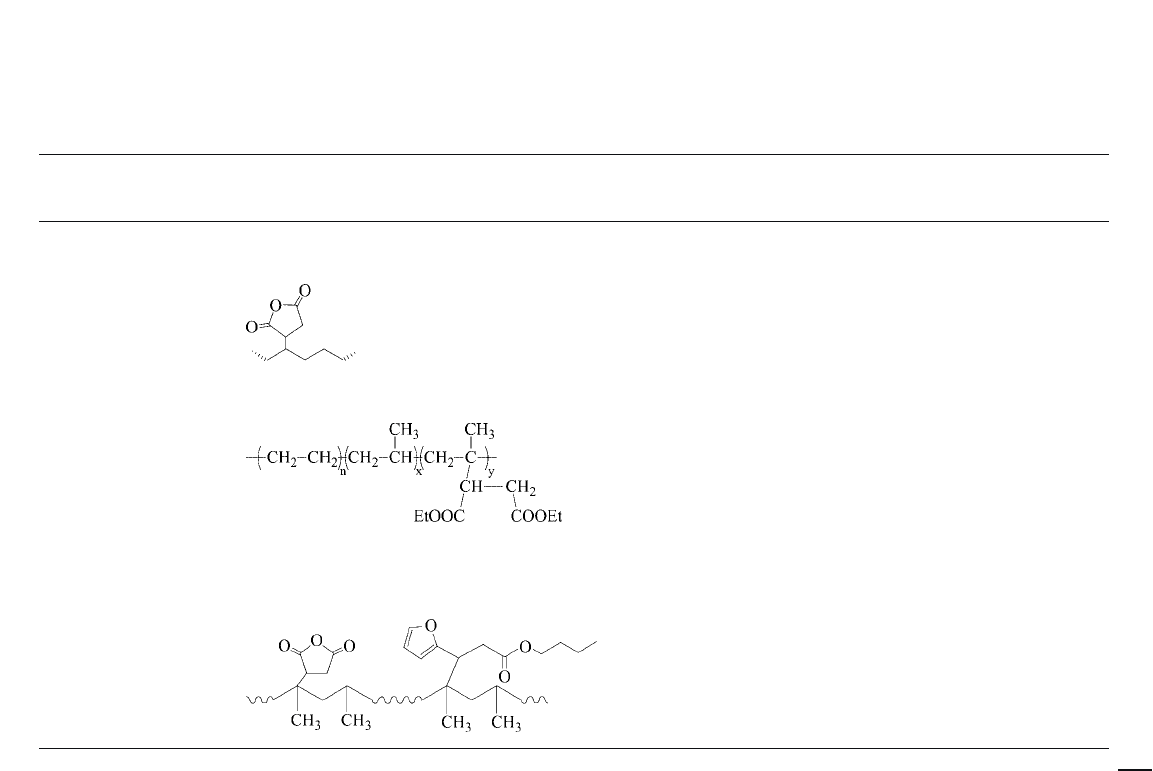
13.2 Polyolefi n-Based Nanocomposites 419
Types of compatibilizer for
PO/OLS systems
Examples Main characteristics Reference(s)
Randomly functionalized
polyolefi ns
Maleic anhydride (MAH) - functionalized
polyolefi ns
Functionalization degree ranging between 0.1
and 2% by mol
[32, 48, 51 – 55, 72,
77 – 82]
Diethyl maleate (DEM) - functionalized polyolefi ns
Functionalization degree ranging between 0.1
and 2% by mol
[32, 79 – 81, 83 – 85]
Maleic anhydride (MAH) and Butyl furanyl
propenoate (BFA) - functionalized polypropylene
Functionalized polypropylene having high
molecular weight
[86 – 89]
Table 13.4 Continued.
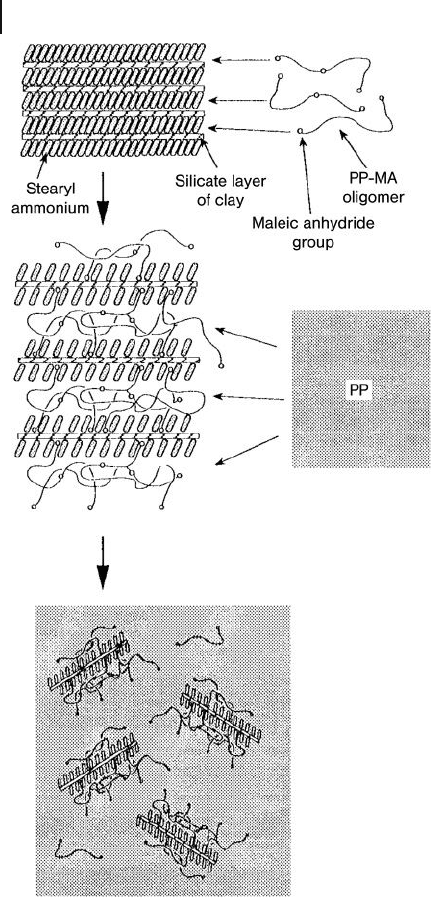
420 13 Nanocomposites Based on Phyllosilicates
Figure 13.3 Schematic representation of the dispersion
process of the organo layered silicate (OLS) in the
poly(propylene) (PP) matrix with the aid of a maleic anhydride
functionalized PP oligomers. Reproduced with permission
from Ref. [51] ; © 1997, American Chemical Society.

13.2 Polyolefi n-Based Nanocomposites 421
simulation studies and experimental results [74, 90, 91] produced evidence that
end - functionalized polymers – unlike more functionalized polymer systems –
assumed a special confi guration on the clay surface which allowed complete
exfoliation of the clay. In particular, in the case of the PP/OLS nanocomposites,
it was shown that by using an ammonium group - terminated PP (PP - NH
3
+
) as
compatibilizer, the terminal hydrophilic NH
3
+
groups would be attached by cation
exchange on the inorganic surfaces, while the hydrophobic high - molecular - weight
PP tails would aid exfoliation of the structure, though this would be maintained
even after further mixing with undiluted PP [74] . In contrast, side chain - function-
alized PPs or PP block copolymers were seen to form multiple contacts with each
of the clay surfaces, which resulted not only in the polymer chains being aligned
parallel to the clay surfaces, but also consecutive clay platelets being bridged, thus
promoting the production of intercalated structures. This bridging effect was
established, for example, by using side chain - functionalized polyolefi ns character-
ized by large ( > 2 wt%) amounts of grafted polar groups [74, 90, 91] .
Without doubt, however, the most popular compatibilizers are POs functional-
ized with MAH by free radical processes. PP functionalized with MAH (PP - g -
MAH) was shown to intercalate into the inter - galleries of OLS, much like the
analogous oligomers [77] . In fact, a WAXD analysis of the PP/OLS nanocompos-
ites revealed an absence of any peaks representing dispersed OLS in the PP - g -
MAH matrix; hence, in this case also, the strong hydrogen bonds between the
MAH - grafted groups and the polar clay surface promoted dispersion of the layers.
Similar results were obtained for PE – PP rubber (EPM)/OLS nanocomposites
which had been prepared by melt blending EPM - g - MAH and OLS modifi ed with
C18 alkyl ammonium chains, in a twin - screw extruder [78] . Confi rmation of the
intense interactions between the functional groups of the compatibilizer and the
lamellae of OLS was obtained from experiments with nanocomposites that had
been prepared by blending an EPM functionalized with diethylmaleate ( DEM )
(with 1 mol% grafted functional groups) with increasing amounts (up to 20 wt%)
of OLS. The use of a functionalized, rather than virgin, EPM allowed (in the case
of 5 wt% OLS nanocomposites) the shift to be made from an intercalated morphol-
ogy to an almost completely exfoliated morphology [83] (Figure 13.4 ).
It was hypothesized that the hydrogen bonds between the – OH groups present
on the OLS surface and the carbonyl groups of the functionalized EPM allowed
both optimization and stabilization of the clay dispersion (Figure 13.5 ). Most
likely, the compatibilizer was placed between the polar silicate layers and con-
temporarily mixed with the nonpolar polymer chains, thus creating a concentra-
tion gradient suitable for providing an exfoliated morphology and avoiding phase
separation.
The strong interactions between the OLS and the EPM - g - DEM were confi rmed
by extracting the nanocomposites with hot toluene; a signifi cant proportion of
the rubber proved to be insoluble (up to 55 wt% for 15 – 20 wt% OLS), and the
amount of nonextractable polymer was increased by raising the OLS loading [32,
84] . The occurrence of strong polymer/clay interactions was also proved by com-
paring the infrared ( IR ) spectra of the composite and residue (Figure 13.6 ). The
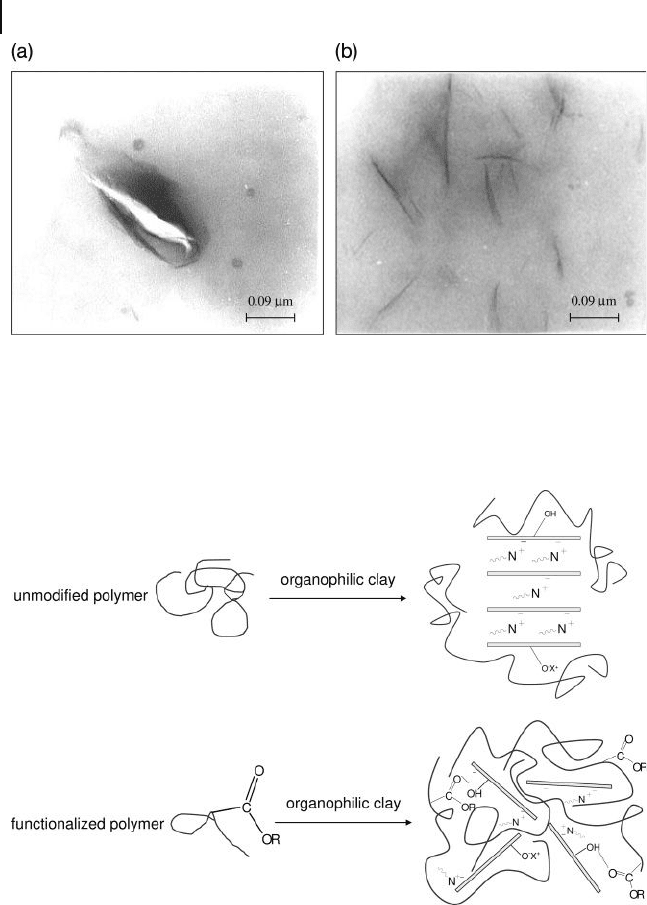
422 13 Nanocomposites Based on Phyllosilicates
Figure 13.4 Transmission electron microscopy images
of (a) ethylene propylene rubber (EPM)/organo - layered silicate
(OLS) and (b) EPM functionalized with diethyl maleate
(EPM - g - DEM)/OLS 5 wt% nanocomposites. Reproduced with
permission from Ref. [84] ; © 2005, John Wiley & Sons, Ltd.
Figure 13.5 Effect of organophilic and polar interactions on
the morphologies of ethylene – propylene rubber (EPM) and
EPM functionalized with diethyl maleate (EPM - g - DEM)/
organo - layered silicate (OLS) composites.
C = O stretching band of the carbonyl ester group of the EPM - g - DEM, when
retained in the toluene - extracted residue, was signifi cantly broad and was shifted
to lower wavenumbers compared to neat EPM - g - DEM. Moreover, the shoulder at
approximately 1715 cm
− 1
suggested a hydrogen - bond interaction between the EPM
functional groups and the silicate surface [85] .
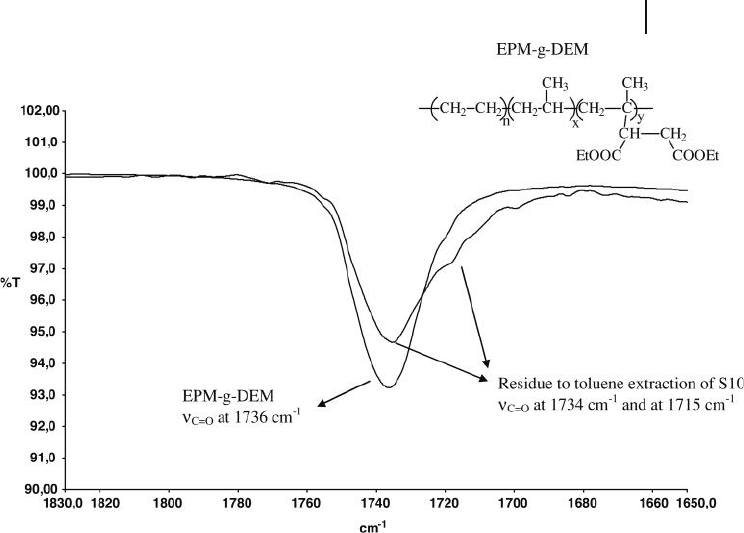
13.2 Polyolefi n-Based Nanocomposites 423
Figure 13.6 Attenuated total refl ectance (ATR)
spectra of ethylene – propylene rubber
functionalized with diethyl maleate (EPM - g -
DEM) and residue to toluene extraction of a
PE - g - DEM/organo - layered silicate (OLS)
nanocomposite 10 wt% OLS. Note the
enlargement of the C = O stretching region.
Reproduced with permission from Ref. [84] ;
© 2008, Elsevier Ltd.
Evidence of the strong interaction between the EPM - g - DEM and the layered sili-
cate was also provided with differential scanning calorimetry ( DSC ) and dielectric
relaxation analyses. Initially, the insoluble toluene fraction was seen to have a glass
transition temperature ( T
g
) which was appreciably higher than that of the original
composite. Furthermore, the dielectric relaxation analysis of nanocomposites indi-
cated a reduction in both the dielectric strength and α - relaxation frequency as the
temperature was increased (Figure 13.7 ). As the dipolar relaxing units are the side
DEM grafted groups, this phenomenon was explained by considering a partial
immobilization of such groups on the silicate surface, as consequence of the
nanoconfi nement of polymer chains. The α - relaxation was shown to disappear
for the residue to the toluene extraction, while the cooperative dynamics of the
dipolar groups of EPM - g - DEM were strongly reduced as they were interacting with
the layers.
The amount of unextractable polymer, the existence of which confi rms the
polymer/OLS interactions, and can be related to an adsorbed/interacting
confi ned polymeric fraction, was correlated (using a rough geometric model) to
the volume occupied by trapped and intercalated macromolecules (Figure 13.8 ).

424 13 Nanocomposites Based on Phyllosilicates
This comparison between experimental and theoretical data provided evidence of
the existence of different interaction levels between the polymer and the organo-
philic clay, which together caused the formation of an unextractable polymer,
namely:
• polymer – surfactant interactions
• polymer – clay surface chemical and physical interactions
• intercalated polymer – bulk polymer interactions.
By applying this model, the PO/OLS nanocomposite can be considered as a system
containing at least two phases: (i) the polymer matrix, which does not truly interact
with the layers ’ surface (and thus is extractable with the same T
g
of pristine PO);
and (ii) a nanostructured phase containing polymer chains that strongly interact
Figure 13.7 Dielectric loss spectra of
nanocomposite organo - layered silicate (OLS)
20 wt% (closed symbols) and its residue to
solvent extraction (open symbols) above the
glass transition temperature. The same
symbol type corresponds to the same
measurement temperature. Reproduced with
permission from Ref. [84] ; © 2008, Elsevier
Ltd.
Figure 13.8 Schematic model of polymer confi nement.
Reproduced with permission from Ref. [84] ; © 2008,
Elsevier Ltd.
